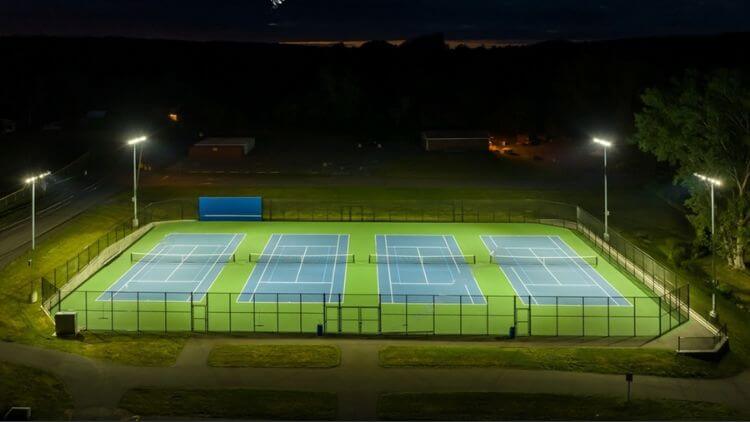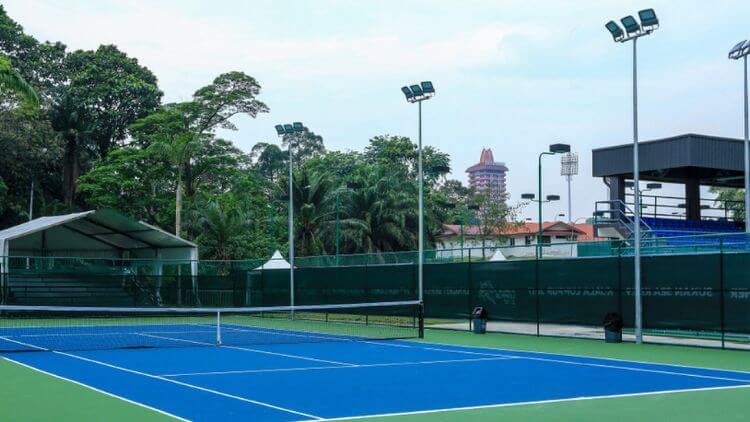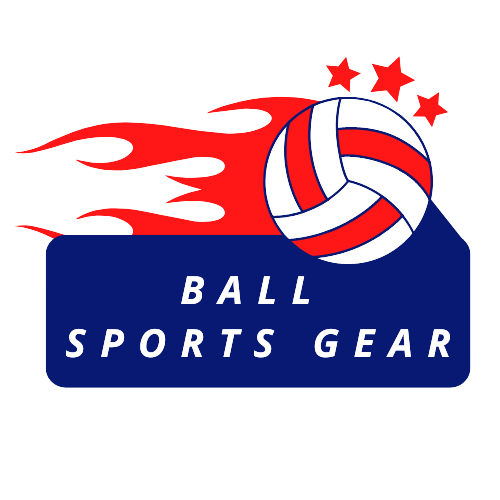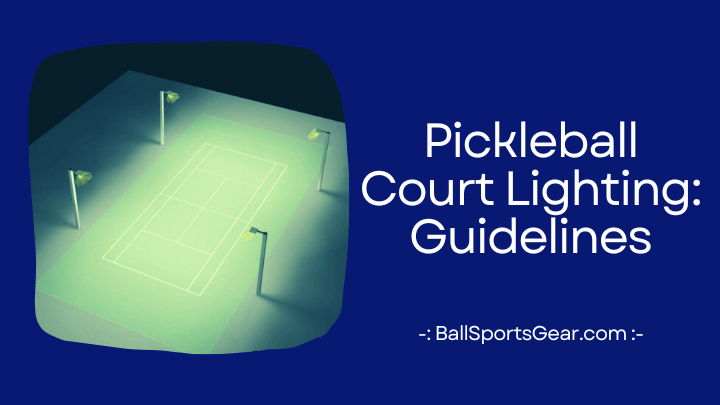In recent years, pickleball, a rapidly expanding sport that incorporates aspects of table tennis, badminton, and tennis, has experienced tremendous growth. The need for well-equipped and well-lit pickleball facilities has substantially expanded as pickleball aficionados continue to swarm to courts throughout the world. The installation of efficient court lighting is a crucial component in creating the best possible playing environment. The significance of pickleball court lighting will be explored in this article, along with its advantages, drawbacks, and effects on the general playing experience.
Factors to Consider for Pickleball Court Lighting
A. Lighting Requirements and Standards:
When it comes to pickleball court lighting, adhering to specific pickleball court lighting requirements and standards is essential to ensure optimal visibility and player safety. The Illuminating Engineering Society (IES) and the American Sports Builders Association (ASBA) provide guidelines for lighting levels and uniformity on sports courts. These guidelines typically recommend a minimum average illuminance level of 30 foot-candles (fc) for outdoor pickleball courts. Additionally, uniformity ratios of 0.7 or better should be achieved to minimize shadows and ensure even lighting across the playing area.
B. Pickleball court lighting layout and Size:
The pickleball court lighting layout and size of the pickleball court play a significant role in determining thepickleball court lighting requirements. Pickleball courts are typically 20 feet wide and 44 feet long, with a non-volley zone (NVZ) on each side. The lighting fixtures should be strategically positioned to provide uniform illumination across the entire playing surface, including the NVZ areas. The height of the fixtures and their distance from the court also impact lighting distribution and glare control.
C. Types of Lighting Fixtures:
For pickleball courts, selecting the appropriate lighting fixtures is essential to getting the correct illumination levels and quality. Due to their energy economy, extended lifespan, and superior lighting output, LED (Light Emitting Diode) fixtures have become more and more popular in recent years. LED lighting reduces light pollution and lessens disruption to surrounding regions by providing strong, concentrated illumination with less light leakage. Furthermore, LED lighting fixtures may be muted or manipulated to accommodate various lighting needs and energy-saving techniques.
D. Energy Efficiency and Cost Considerations:
Efficiency and pickleball court lighting cost considerations are important when selecting pickleball court lighting solutions. LED lighting fixtures are known for their energy efficiency, consuming significantly less electricity compared to traditional lighting technologies such as metal halide or high-pressure sodium lamps. This translates to reduced operating costs and lower environmental impact. Additionally, LED lights have longer lifespans, resulting in reduced maintenance and replacement expenses over time. Although the upfront cost of LED fixtures may be higher, the long-term benefits and pickleball court lighting cost savings make them a worthwhile investment.
How Do You Light A Pickleball Court?
When it comes to lighting a pickleball court, the primary goal is to ensure maximum visibility on the playing surface, especially during low-light conditions. Adequate lighting allows players to track the ball’s trajectory, anticipate shots, and maintain safety on the court. To achieve this, modern pickleball court illumination often relies on LED fixtures that are specifically designed for outdoor tennis or pickleball courts.

LED Fixtures: A Game-Changing Solution
Pickleball courts and other sports illumination have both been transformed by LED (Light Emitting Diode) lighting. These lights are the best option for illuminating outdoor recreational places since they have various advantages over conventional lighting systems.
- Enhanced Visibility: LED lighting has exceptional colour rendering capabilities that mimic natural sunshine and increase court visibility. Players will be able to see the ball clearly and react swiftly and precisely as a result.
- Energy Efficiency: LED technology is highly energy-efficient compared to traditional lighting options. LED fixtures consume significantly less electricity, leading to reduced energy costs and environmental impact. Additionally, they have a longer lifespan, reducing the need for frequent replacements and maintenance.
- Uniform Illumination: LED fixtures can deliver uniform lighting across the pickleball court, minimizing shadows and dark spots. This even distribution of light enhances the playing experience by eliminating distractions and ensuring consistent visibility throughout the game.
- Instant On/Off: LED lights have an instant on/off capability, eliminating warm-up and cool-down periods. This feature allows for immediate illumination when needed, enhancing convenience and reducing energy wastage.
- Durability: LED fixtures are built to withstand outdoor conditions, making them resistant to shocks, vibrations, and extreme weather. Their robust design ensures they can endure the demands of outdoor pickleball courts and require minimal maintenance over time.
Lighting Design Considerations:
When planning the lighting design for a pickleball court, several factors must be taken into account to ensure optimal visibility and performance. Here are some key considerations:
Light Distribution: The fixtures should be strategically positioned to minimize glare and shadows. Proper distribution of light ensures that players can see the entire court without any visual obstructions.
Light Levels: The lighting system should meet the recommended light levels for pickleball courts. Illumination requirements may vary depending on the court’s location, size, and level of competition. It is crucial to consult lighting professionals or adhere to industry guidelines to determine the appropriate light levels for your specific court.
Glare Control: Glare can be a significant distraction and hinder players’ performance. The lighting fixtures should be equipped with proper shielding and optics to minimize glare and ensure a comfortable playing experience.
Maintenance and Controls: Consider using lighting fixtures with remote control capabilities or automation systems that allow easy adjustments to light levels. This flexibility enables customization based on different playing conditions and helps conserve energy when the court is not in use.
Recommended lighting solutions for pickleball courts
A. LED lighting systems:
When it comes to illuminating pickleball courts, LED lighting systems are the preferred choice for several reasons. LED lights offer exceptional energy efficiency, allowing you to save on electricity costs while providing bright and uniform lighting across the court. They have a longer lifespan compared to traditional lighting options, reducing the need for frequent replacements and maintenance. LED lights also offer instant-on capabilities, eliminating warm-up time and providing consistent illumination without flickering.

B. Adjustable and dimmable lights:
Pickleball courts often require adjustable lighting to accommodate various game scenarios and player preferences. Adjustable lights allow you to control the intensity of illumination, ensuring optimal visibility for players. Dimmable lights are particularly useful during evening games or in indoor facilities, where you may want to create a more intimate ambiance. These lighting options provide flexibility, allowing you to adapt the lighting conditions to different events and player needs.
C. Lighting controls and automation:
To enhance convenience and efficiency, consider incorporating lighting controls and automation into your pickleball court lighting system. With advanced control systems, you can easily manage and customize the lighting settings, such as adjusting brightness levels or turning lights on and off remotely. Automation features can be utilized to schedule lighting according to specific game times or occupancy, ensuring that the court is properly lit when needed and conserving energy when not in use. Additionally, motion sensors can be integrated to activate lights when players enter the court and switch them off automatically after a period of inactivity.
D. Maintenance and durability of fixtures:
Investing in durable and low-maintenance lighting fixtures is essential for pickleball courts, as they are often subject to intense use and various weather conditions. Opt for fixtures that are designed specifically for outdoor or indoor sports applications, ensuring they are resistant to impact, vibration, moisture, and dust. Led pickleball court lighting, known for their durability, are an excellent choice, as they have no fragile components like filaments or tubes. Regular maintenance and inspection of the lighting system are also important to address any issues promptly and ensure the continued performance and longevity of the fixtures.
Frequently Asked Questions
A: The number of lights required for a pickleball court depends on several factors, such as court size, lighting type, and desired light levels. However, a common recommendation is to have at least four light fixtures per court. The exact number and placement of lights can vary based on specific lighting requirements and court dimensions.
A: Lighting regulations or guidelines for pickleball courts may vary depending on the location and local authorities. It is essential to consult with relevant authorities, such as municipal authorities or sports organizations, to understand any specific lighting requirements, such as recommended light levels, light spillage limits, or lighting curfews.
A: Yes, existing pickleball courts can be retrofitted with lighting. However, the feasibility and cost of retrofitting will depend on the court’s design, electrical infrastructure, and other factors. It is recommended to consult with a professional lighting installer or contractor to assess the feasibility and discuss the best retrofitting options for your specific court.
Conclusion
In conclusion, adequate lighting plays a crucial role in enhancing the pickleball experience for players of all skill levels. From extending playing hours to improving visibility and safety, well-designed court lighting ensures that players can fully enjoy the game, regardless of the time of day. When constructing or upgrading pickleball facilities, it is essential to prioritize the installation of proper lighting systems that meet the specific requirements of the sport. By doing so, pickleball enthusiasts can enjoy thrilling matches and foster a vibrant and welcoming community that continues to propel the growth of this exciting sport.

